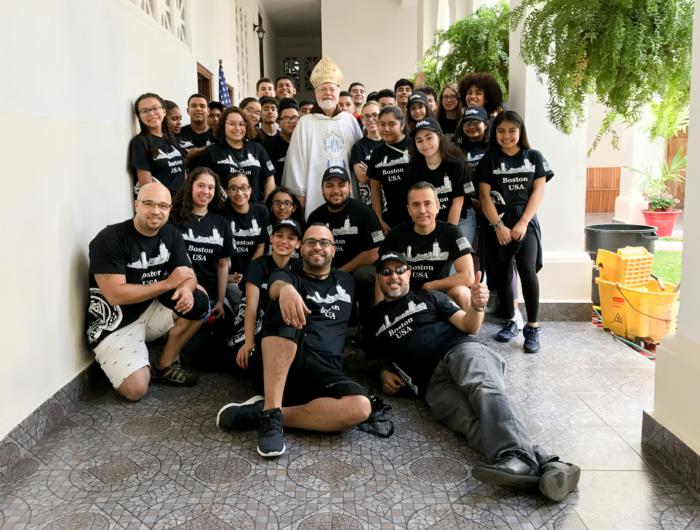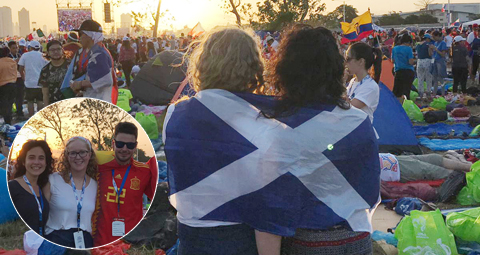------------------------------------------------------------------------------------------------------------
 |
| Dr Neil Xavier O'Donoghue meeting Pope Francis. |
Chai Brady speaks to a renowned Catholic academic about his life and Faith
“Do not be afraid to be holy” was then Pope John Paul II’s message to pilgrims during World Youth Day in 1989, and that struck a chord with a young man soon to enter seminary.
Dr Neil Xavier O’Donoghue, now a lecturer of Systematic Theology in St Patrick’s College in Maynooth, was “impressed” by what St John Paul II said.
“That was his refrain there, and to see that Christianity was an option to me, I see that a vocation is a vocation to Christianity not to the priesthood per say. The main vocation is to Holiness, within that you have to discern what it is, and I discerned that it was a vocation to the priesthood,” he said.
However, this wasn’t the only thing that helped him on his Faith journey.
Serious
Growing up in Ballincollig, Co. Cork, the eldest of two brothers and a sister, Dr Neil became more serious about his Faith after his teenage years.
“I suppose it was at the World Youth Day in Santiago Del Compostela, which was just after my Leaving Cert before starting in UCC. During that year I was discerning and I saw the vocation more clearly at the end of that year,” he said.
He joined the Neocatechumenal Way, a charism in the Church dedicated to Christian formation. After that pilgrimage in Spain with the group’s youth community and the then Pope’s message, he had a vocational meeting.
His US adventure began when he was chosen at random to go to New Jersey. “I was 18 at the time, it was an adventure it was no problem. At the time I didn’t know which side of the US New Jersey was on, but I was up for it,” he said.
Dr Neil spent 10 years as a seminarian in the Redemptoris Mater Seminary in Newark. Five of those years were spent as a missionary in Atlanta, Miami and Washington DC.
Seminarians
It was in 2013 that Cardinal Brady asked his bishop in the US, Archbishop John Myers at the time, to borrow him to help establish the new Redemptoris Mater Seminary in Dundalk and “get it off the ground”. He had already taught seminarians in the US for 11 years and went on to spend five years teaching seminarians in Dundalk.
Archbishop Myers agreed and it was back home for Dr Neil who served there as Vice Rector of the seminary of the Archdiocese of Armagh and as a curate in a number of parishes in Dundalk and south Armagh.
Discussing the differences between working as a priest in Ireland and the US he said that ultimately there was very few.
“People are more or less the same on one level, on another level I think the Church is a bit different in the States because it is bigger so you have more room for variety whereas here you have a one size fits all reality. In the States different parishes have a difference emphasis, they have that advantage over us I suppose,” he said.
Dr Neil then decided to move into academics after a discussion with his archbishop, Cardinal Joseph Tobin CSsR of Newark.
He said: “I’m settling into the job here I’ve written a lot about the Church in early Ireland, about the way the Eucharist was celebrated. My doctorate was in the Eucharist in pre-Norman Ireland and so I’ve done some work on that and on liturgical renewal in general.”
Teaching systematic theology, he says the ultimate question within students is whether the Good News is real.
“That’s the ultimate question, is all this real? That is the question that each students has to answer for themselves above and beyond the actual mechanics of getting a degree in theology,” he said.
Dr Neil also writes a monthly column for the Messenger of St Anthony where he focuses on the theology of the Pope.
Speaking about the topic he found most interesting related to his writings on the Pope he said: “I suppose it would be his emphasis on forgiveness which would be the most important one with Pope Francis, I suppose the power of Confession is a big deal with him.
He also does some blogging on praytellblog.com, which is sponsored by the Benedictine Abbey of Collegeville and is the author of several books.


